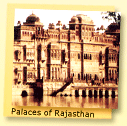|
 |
|
Welcome |
|
Rajasthan Tours |
|
|
|
|
|
|
|
|
|
|
|
|
|
|
|
|
|
|
|
|
|
|
|
|
|
|
|
|
|
|
 |
|
|
Rajasthan has a diverse landscape that ranges from the
scrub-thorn forests, semi-arid barren desert, and rocks to
wetlands, water-filled valleys and lush green forests. The
Thar Desert also known as the Great Indian Desert, wetlands
of the Indo-Gangetic plains and the Aravali mountain range
play an important part in the landscape of Rajasthan.
Rajasthan is a dwelling of different variety of wildlife
animals and birds like chinkara, the endangered caracal,
rare desert fox, tigers, black bucks, the great Indian
bustard, wild boars, bears and deers. Migratory birds
which usually visit Rajasthan during winters are: the rare
Siberian cranes, imperial sand goose, falcons, common
cranes, coots and pelicans. There are 2 national parks and a
number of sanctuaries in Rajasthan. Almost all the
sanctuaries are opened throughout the year and are closed
during the monsoon.
Some of the national parks and wildlife sanctuaries of Rajasthan
are:
|
|
Bhensrod
Garh Sanctuary, Kota |
|
A fairly new
sanctuary, it was established in 1983 and covers a total area of 229 sq km
of scrub and dry deciduous forest. The Bhensrod Garh sanctuary is located
55 km west of Kota and covers a total area of 229 sq km of scrub and dry
deciduous forest. Bhensrod Garh is one of the new additions in the list of
Wildlife Parks or Sanctuaries as protected home to variety of rare as well
as endangered animal and bird species. Wild animals generally seen in the
park are Sloth Bear, Chinkara and Leopard. Best Season to visit this
sanctuary is from October to May. |
|
Darrah
Sanctuary, Kota |
|
Darrah
Sanctuary was founded in the year 1955 in Kota , it spreads over an area
of 266 square km. It is enclosed by thick forests and hills. In the days
of yore, Darrah sanctuary used to be the royal hunting ground of the
erstwhile maharaja of Kota before it was handed over to the government of
India. The animals which are generally seen in the park are chinkara,
leopard, wolf and sloth bear. Best Season to visit this sanctuary is from
February to May. |
|
Desert National Park, Jaisalmer |
|
Desert
National Park was set up in 1980 in Jaisalmer, it spreads over an area of
3162 square km. Best Season to visit this park is from September to
March. Desert National Park is a best example of the
ecosystem of the Thar Desert. Sand dunes form around 20% of the Park. The
major landform consists of craggy rocks and compact salt lake bottoms,
intermedial areas and fixed dunes. Besides a fragile ecosystem there also
exists a wide variety of birdlife. This region is a heaven for the
migratory and resident birds of the desert. Many eagles, harriers,
falcons, buzzards, kestrel and vultures. Short-toed Eagles, Tawny Eagles,
Spotted Eagles, Laggar Falcons and kestrels are the mostly common among
these. Spotted near small ponds or lakes here are Sand grouse. |
|
Jaisamand
Sanctuary, Udaipur |
|
Jaisamand Sanctuary was set up in 1957 in Udaipur. It is
situated on the edges of the Jaisamand lake, a huge
man-made lake and spreads over an area of 160 square km.
This sanctuary is the habitat of innumerable species. The species
include sloth bear, leopard, chital, chinkara, wild boar
and a wide variety of the birds that breed here such as
darter, open bill stork, pond heron, little cormorant and
Indian Shag. The aquatic life and the amphibians are also
found in the lake such as the fish and the crocodiles.
Best Season to visit this sanctuary is from November to
January. |
|
Keoladeo Ghana National Park, Bharatpur |
|
Bharatpur Bird Sanctuary also known as Keoladeo Ghana National Park is
one of prominent bird sanctuary in the world. It is the largest bird
sanctuaries in Asia. It was founded in the year 1956 and was declared
as a national park on 10 March 1982. It is among one of the best bird
sanctuaries. This sanctuary covers an area of about 29 square kms. In
this sanctuary more than 280 species of birds are found. Different
types of migratory birds come here from Russia and Siberia during
winters. Different varities of migratory birds who visit the
sanctuary include Brahminy ducks, herons, Siberian crane, geese,
pelicans, egrets, ibis etc. The sanctuary is a very peaceful place to
watch unique Indian and foreign birds.
Best
Season to visit this sanctuary is from November to February. More..... |
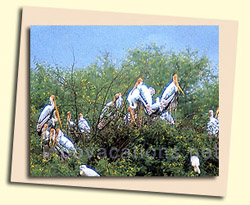 |
|
|
Kumbhalgarh Sanctuary, Kumbhalgarh |
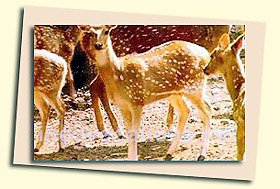 |
Kumbhalgarh Sanctuary is a very large sanctuary in the Aravallis,
situated about 118 km from Udaipur. It
extends
over an area of 586 square km. Wild animals which are found in the
sanctuary are Wild Boar, Four-horned Antelope, Panther, Sloth Bear
etc. One of the most important attraction of the sanctuary is
scientifically bred crocodiles.
The
sanctuary becomes the dwelling of various migratory birds like
Spoonbills, Egrets, Flamingoes, Cormorants etc. during winters.
Best Season to visit this sanctuary is from March to May and from
September to November. |
|
|
Mount Abu Sanctuary, Mount Abu |
|
The Mount
Abu Wildlife Sanctuary is situated in the Aravali mountain ranges. The
area was declared as a wildlife sanctuary in 1960. The Mount Abu
Wildlife Sanctuary is one of the oldest parts of the Mount Abu mountain
ranges. The Mount Abu Wildlife Sanctuary is about 7 kms long and
only 300 metres wide. It is the home of a large variety of animals like
Wild boar, grey Jungle Fowl, Sambhar, Langur, Chinkara, and Leopard.
The Mount Abu Wildlife Sanctuary houses about 112 plant families
with 449 genera and 820 species.
|
|
Ranthambore
National Park, Ranthambore |
|
Ranthambore National Park is a famous tiger reserve in Ranthambore. It
spreads over an area of 392 square km. This national park is the
residence of a large variety of animals. It is one of the most
beautiful and scenic park of the country due to its amazing landscape
with its lake, fort and temples. Most Prominent attraction of this
park is Tiger. Other attractions of this park are Jungle Cat, Jackal,
Sloth bear, Hyena, Wild Boar, Indian Hare, Marsh Crocodile, Leopards,
Deer, Antelopes, Sambhar, Chinkara, Chital, Nilgai, Caracals,
Porcupines, Mongoose etc. Best Season to visit this park is from
November to March.
Ranthambore National Park was a hunting ground of the Maharaja of
Jaipur in the beginning. In the year 1955, Ranthambore was given the
status of game sanctuary.
More..... |
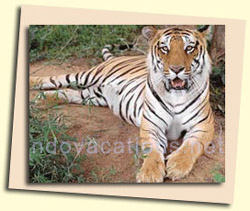 |
|
|
Sariska
National Park, Sariska
|
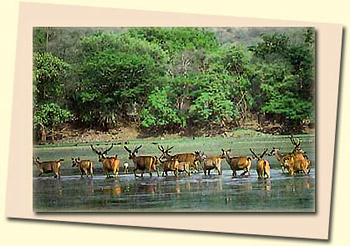 |
Sariska National park is
one of most prominent Wildlife Reserve of India.Sariska
National Park is located on the Aravalli and spreads over an area of
500 square km.
Sariska
was the hunting ground of the Maharajas of Alwar in the beginning, in
the year 1958 it became a wildlife sanctuary by the government of
India. Sariska National park is one of most prominent Wildlife Reserve
of India. It came under Project Tiger in 1979 and was declared as a
national park in 1982.
Wild
animals which are generally seen in the park are: Tiger, Leopard,
Hyena, Sambhar, Chital, Nilgai, Wild Boar, Jackal, Wild dog, Jungle
Cat, Four-horned Antelope, Crocodiles, Common Langur, Caracal and
Porcupines. Various species of birds can also be seen in Sariska
National Park. Best Season to visit this park is from November to
June.
More.... |
|
|
Sitamata Sanctuary, Udaipur
|
|
Sitamata Sanctuary is situated about 105 kms from Udaipur. It is
enclosed by the forests of bamboo and dry deciduous vegetation. Sitamata
Sanctuary is the dwelling of a large variety of wild animals like
Chousingha, Deer, Caracal, Wild Boar, Pangolin and Leopard. |
|
|
|
Talchappar Sanctuary, Shekhawati
|
|
Talchappar Sanctuary is situated in the Shekhawati region of Rajasthan.
Wild animals which are found in this sanctuary are: Desert Fox,
Sandgrouse, Blackbuck, Desert Cat, Partridges etc. |
|
|
|
SHIKAR (Hunting in
Rajasthan which is nor more allowed)
Rajasthan’s picturesque forests dotted with hills and lakes are
well-stocked with a variety of wild life. In fact, shikar used to be a
favourite sport with the princes and the nobility. The tradition is kept
alive today, and the State Government have taken steps to preserve the
colourful fauna of the region.
Rajasthan is specially known for tiger shoot, pig sticking and imperial
sand-grouse and migratory duck shoots. For those who wish to oberve wild
life or ‘shoot’ with a camera, there are sanctuaries where birds and
animals live in their natural habitat without fear of molestation. In
brief, Rajasthan affords ample opportunities within easy reach of the
principal cities, whether one desires to shoot with a gun (no more
allowed) or a camera.
Big Game in olden times since the Royal time
The forest
areas where wild life was plentiful and had been divided into shooting
blocks. Each block had three to four water-holes and a few good camping
grounds within easy approach of a rest house or a town. The schooting
season started in October and lasted till the end of March. The tiger and
the panther could, however, be shot till the end of June. In fact, the
best time for a tiger shoot was between March and June when game was
abundant. The days, during these
months, are warm but dry and healthy and the nights cool and pleasant.
A variety of good game was available in the forest areas around Alwar,
Bharatpur, Dholpur, Karauli, Sawai Madhopur, Kotah, Bundi, Baran and
Jhalawar. Tigers and panthers, were common in these forests and with
reasonable luck, a hunter might secure other trophies, such as the bear,
sambhar, blue bull, chinkara, cheetal and occasionally a wild boar. In the
southern parts of the State, bears were found in most of the forests.
Kotah forests had brown bears in addition to the black variety. The
sambhar were distributed all over the region, but the spotted deer was
available only in the southern parts. Wild pigs, blue bulls, black bucks
and chinkaras were well distributed throughout the State. The four-horned
antelope was met with at a few places, between Alwar and Jaipur.
Feathered Game
During the winter months, feathered game was plentiful in many parts
of Rajasthan.
Bikaner and Bharatpur
are famous for imperial sand-grouse and duck shooting. A record number of
6,000 birds of each species had been bagged in a day at these places. Also
commonly found wete the great Indian bustard, grey and black partridges,
fowls, four kinds of quail and snipe, green and blue pigeons, floricans,
plovers, teals, geese, pochards and ducks of many kinds.
Game Sanctuaries in Rajsathan
To ensure
the preservation of wild life a few blocks have been declared by the State
Government
as
reserved areas or Game Sanctuaries. These are Sariska in Alwar, Keoladeo
Ghana in Bharatpur, Van Vihar in Dholpur, Darrah in Kotah, Jaisamand in
Udaipur and one in Sawai Madhopur. Shooting, hunting, netting and trapping
of animals and birds are prohibited in these areas. The visitor, however,
is welcome to study wild life and ‘shoot’ with a camera.
Of the five game sanctuaries, those at Sariska
and
Ghana are the more popular, for they are easily accessible. The Sariska
Game Sanctuary is 193 km. (120 miles) from Delhi on the Delhi-Jaipur road.
It has tigers, panthers, wild boars, black bucks, four-horned deer,
sambhars, blue bulls, jungle cats, civets and hyaenas. Among the colourful
birds are the pea-fowl and golden orioles.
The Ghana Bird Sanctuary at Bharatpur is a vast
marsh where thousands of migratory ducks come for the winter. A large
number of storks, cormorants, darters, spoon-bills, egrets and cranes
build their nests and breed there, and the whole place resounds with the
calls of millions of young chicks during August-September. Apart from the
birds,
Ghana has herds of black bucks, cheetals and bule bulls which can be
photographed from close range. |
|






